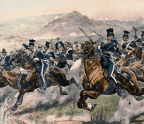THE FIGHT FOR THE 14TH COLONY

By the mid-18th century American Indians in New England had been subjected to a century and a half of unsolicited hardship—succumbing to unfamiliar diseases brought by European colonists, increasingly dislodged by encroaching settlers, hunted down by soldiers, and used as pawns in the struggle for dominion between Britain and France. The latter ostensibly culminated with the end of the French and Indian War in 1763, though anyone believing that marked the end of conflict on North American soil was in for a rude awakening. War drums were soon beating once again, auguring a conflict that would again force the region’s Indians to choose sides.

The end of the French and Indian War was a particularly perplexing time for Indians in northern New England and Nova Scotia. The signing of the 1763 Treaty of Paris ceded much of what had been New France to the British, and King George II’s subsequent Royal Proclamation that year set aside the largely uncolonized territory west of the Appalachian Mountains as an Indian reserve, off limits to settlement—at least for the time being. As for the land between the Appalachians and the Atlantic Ocean, the Indians were told it was the domain of the British Crown. But the people who had been there before the Europeans had never considered themselves subjects of either European power, merely allies, thus the treaty signed by the French and British meant nothing to them.

With the end of the war came a tide of British colonists, many of whom pushed farther north and inland. Responding to a plea for settlers from Charles Lawrence, governor of the British province of Nova Scotia—a region spanning present-day eastern Quebec, the Maritime Provinces of New Brunswick, Nova Scotia, Prince Edward Island and far northern Maine—8,000 so-called “New England Planters” ventured north. (At the time most of Maine
You’re reading a preview, subscribe to read more.
Start your free 30 days



